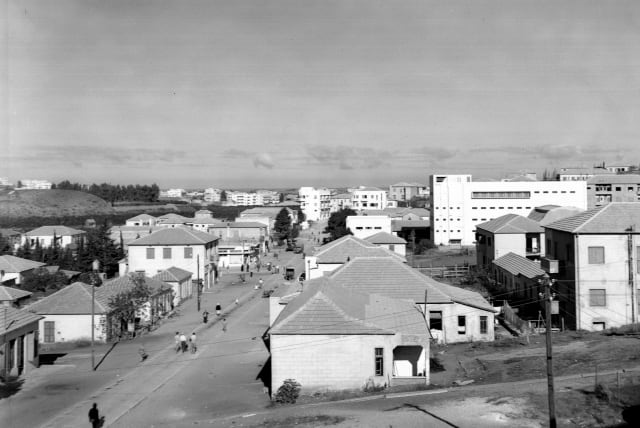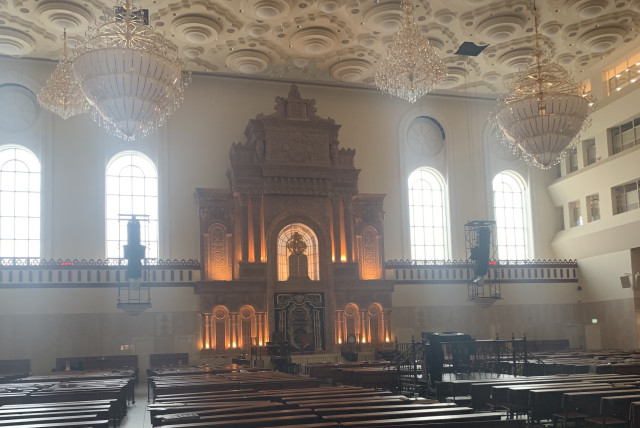Was Bnei Brak Jewish community's founding blessed by a hassidic rebbe?

Did the Sochaczewer Rebbe stand in the street of Bnei Brak and pronounced this rare blessing with God’s name.
The Talmud records the tradition of a blessing recited upon the establishment of Jewish communities after the destruction of the Temple in Jerusalem:
“One who sees houses of Israel in their inhabited state, says – Blessed [are you, Lord our God, king of the universe,] who sets firm the widow’s boundary stone” (Brachot 58b).
The wording of the benediction is drawn from a biblical verse: “The Lord will tear down the house of the proud, but He will set firm the widow’s boundary stone” (Proverbs 15:25). The imagery follows Scripture’s description of Israel and Jerusalem as a vulnerable and lonesome widow after the destruction of the First Temple. “How she sits alone, the city once great with people. She has become like a widow. Great among nations, princess among provinces, reduced to forced labour” (Lamentations 1:1). In contrast to exile, here God is reestablishing the widow’s homestead.
Classic codifiers of Jewish law – such as Maimonides and Rabbi Yosef Karo – record the benediction. Rabbinic authorities discuss the type of building, location and context that warrants the blessing. Should the blessing be recited over private homes, or was it coined for public, Temple-like synagogues? Was the blessing created specifically for buildings in the Land of Israel or even for those outside the Holy Land? Since the blessing invokes the widow imagery, can the blessing be said even though there is still no Temple? Some authorities suggest recitation of the blessing without God’s name as a way to preserve the practice despite the doubts.
Partly because of the lack of clarity regarding the conditions that warrant the blessing, partly due to the rarity of new structures, and partly due to general hesitance to use God’s name lest it be in vain, the blessing seems to have fallen into disuse.
THE MODERN return to Zion triggered renewed interest in this distinct benediction. Indeed, there are testimonies of rabbis reciting the blessing at the dedication of new synagogues in the Holy Land or when they first visited new places in the Land of Israel. One such vignette recounts the 1935 visit of Rabbi Dovid Bornsztain (1876-1942), the third hassidic master from the Sochaczew dynasty.
A hassidic master's visit to 1935's Bnei Brak
Rabbi Bornsztain was an ardent supporter of settling the Land of Israel. In interwar Poland, he was a leader of Agudat Yisrael – one of the forerunners of the Israeli political party currently known as United Torah Judaism. He visited the British Mandate of Palestine in 1924 and again in 1935. On both trips, he visited Bnei Brak.
Back in the day, the ethos of young Bnei Brak was vastly different from the contemporary bustling city. Bnei Brak was a fledgling agricultural settlement that focused on growing citrus fruits. It was founded by Polish hassidic families who had made aliyah between 1924 and 1928 as part of what is described as the Fourth Aliyah. Yitzhak Gerstenkorn (1891-1961) was elected as the first head of the committee of the agricultural settlement in October 1924.
The community steadily grew. A 1931 British census of Palestine recorded a population of 956 Jews who were living in 255 houses. The census reports that there were no Muslims, Christians, Druze, Baha’is, Samaritans or people who declared that they had no religion in Bnei Brak.
In 1941, a member of the committee of the Tel Aviv–Jaffa Jewish community council, Shabbetai Weiss, sent a congratulatory letter to Gerstenkorn in honor of his 50th birthday. Bnei Brak had grown into a regional council, and Gerstenkorn had been elected as its first mayor in 1939 – a position he held until 1954.
Weiss’s letter to Gerstenkorn has been preserved in the archive of Beit Ariela, Tel Aviv’s public library, and in 2018 it was published by librarian Avishai Elboim. In the letter, Weiss recounts a conversation with the Sochaczewer Rebbe during his 1935 visit. The Sochaczewer Rebbe described his visit to Bnei Brak, and Weiss meticulously recorded the exchange:
“I stayed there – said the rebbe – for almost an entire day. I knew a number of the residents from Poland. I inquired about the situation and the affairs of each one of those I knew. Those who accompanied me also told me about the lives and the occupations of others whom I did not know. So-and-so – they pointed out to me – who had been in a difficult situation at the time of my first visit to Bnei Brak, had recovered in the last years and had equipped himself with a respectable livelihood. So-and-so who, after he made aliyah to the Land had lost all his money in various business, had invested himself together with his sons, working the land that he had here, and over time he attained a state of wealth.”
Meeting the Bnei Brak pioneer settlers had moved the Sochaczewer Rebbe, and the excitement was palpable as he recounted to Weiss his visit:
“And after I realized the character of Bnei Brak – the rebbe raised his voice and emotionally stood up from his chair – and the character of its inhabitants who are fused with the location and are toiling to settle it and to expand it, from within a life of Torah and mitzvot and Hassidism, I stood in the street of Bnei Brak and I recited the blessing: Blessed is the one who sets firm the widow’s boundary stone!”
Weiss continued in his letter to recount that after he left the meeting with the Sochaczewer Rebbe, he summarized the details of the lively conversation. As he jotted down his recollections, Weiss realized that Bnei Brak and its development had been the rebbe’s most meaningful encounter. It was those settlers in Bnei Brak “who had brought the hassidic master of Sochaczew to an experience of [spiritual or mystical] excitement.”
From Weiss’s account, it is unclear whether the Sochaczewer Rebbe recited the blessing with God’s name. Perhaps the rebbe had been hesitant to use the Almighty’s name because of the haze surrounding the conditions for the benediction. Or perhaps Weiss had transcribed the blessing in shorthand, just as it appears in shorthand in the Talmud. If this is the case, then the Sochaczewer Rebbe – so moved by the Bnei Brak pioneers who were working the Holy Land, while remaining true to Torah, fulfilling the commandments, and preserving the hassidic way of life – stood in the street of Bnei Brak and pronounced this rare blessing with God’s name. ■
This article was written in honor of the opening of a new synagogue in Tzur Hadassah: Kehillat HaTzur VeHaTzohar’s Beit Knesset Zachor L’Avraham.
The writer is on the faculty of Pardes Institute of Jewish Studies and is a rabbi in Tzur Hadassah.
Jerusalem Post Store
`; document.getElementById("linkPremium").innerHTML = cont; var divWithLink = document.getElementById("premium-link"); if (divWithLink !== null && divWithLink !== 'undefined') { divWithLink.style.border = "solid 1px #cb0f3e"; divWithLink.style.textAlign = "center"; divWithLink.style.marginBottom = "15px"; divWithLink.style.marginTop = "15px"; divWithLink.style.width = "100%"; divWithLink.style.backgroundColor = "#122952"; divWithLink.style.color = "#ffffff"; divWithLink.style.lineHeight = "1.5"; } } (function (v, i) { });

